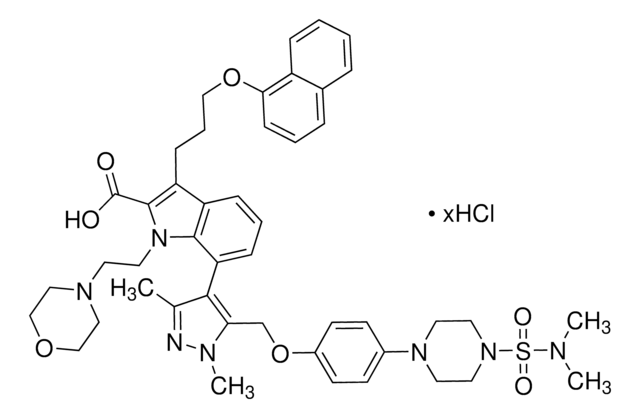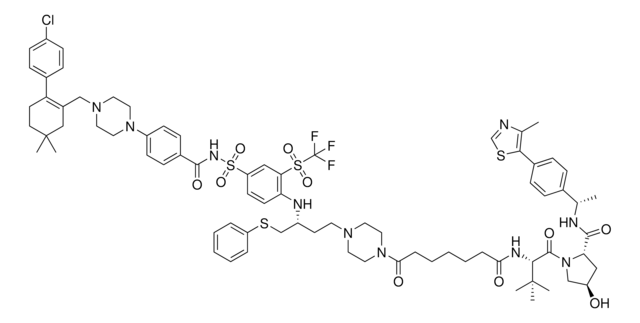197333
ABT-737
≥97% (HPLC), solid, Bcl-2 inhibitor, Calbiochem®
Sinonimo/i:
Bcl-2 Inhibitor VI, ABT-737, 4-{4-[(4ʹ-Chlorobiphenyl-2-yl)methyl]piperazin-1-yl}-N-{[4-({(1R)-3-(dimethylamino)-1-[(phenylsulfanyl)methyl]propyl}amino)-3-nitrophenyl]sulfonyl}benzamide
Scegli un formato
Scegli un formato
About This Item
Prodotti consigliati
Nome del prodotto
Bcl-2 Inhibitor VI, ABT-737, The Bcl-2 Inhibitor VI, ABT-737, also referenced under CAS 852808-04-9, controls the biological activity of Bcl-2. This small molecule/inhibitor is primarily used for Activators/Inducers applications.
Livello qualitativo
Saggio
≥97% (HPLC)
Stato
solid
Produttore/marchio commerciale
Calbiochem®
Condizioni di stoccaggio
OK to freeze
protect from light
Colore
yellow
Solubilità
DMSO: 50 mg/mL
Condizioni di spedizione
ambient
Temperatura di conservazione
2-8°C
Stringa SMILE
[S](=O)(=O)(NC(=O)c3ccc(cc3)N4CCN(CC4)Cc5c(cccc5)c6ccc(cc6)Cl)c1cc(c(cc1)N[C@@H](CSc2ccccc2)CCN(C)C)[N+](=O)[O-]
InChI
1S/C42H45ClN6O5S2/c1-46(2)23-22-35(30-55-37-9-4-3-5-10-37)44-40-21-20-38(28-41(40)49(51)52)56(53,54)45-42(50)32-14-18-36(19-15-32)48-26-24-47(25-27-48)29-33-8-6-7-11-39(33)31-12-16-34(43)17-13-31/h3-21,28,35,44H,22-27,29-30H2,1-2H3,(H,45,50)/t35-/m1/s1
HPLNQCPCUACXLM-PGUFJCEWSA-N
Descrizione generale
Confezionamento
Attenzione
Ricostituzione
Altre note
Oltersdorf, T., et al. 2005. Nature435, 677.
Note legali
Codice della classe di stoccaggio
11 - Combustible Solids
Classe di pericolosità dell'acqua (WGK)
WGK 3
Punto d’infiammabilità (°F)
Not applicable
Punto d’infiammabilità (°C)
Not applicable
Certificati d'analisi (COA)
Cerca il Certificati d'analisi (COA) digitando il numero di lotto/batch corrispondente. I numeri di lotto o di batch sono stampati sull'etichetta dei prodotti dopo la parola ‘Lotto’ o ‘Batch’.
Possiedi già questo prodotto?
I documenti relativi ai prodotti acquistati recentemente sono disponibili nell’Archivio dei documenti.
I clienti hanno visto anche
Filtri attivi
Il team dei nostri ricercatori vanta grande esperienza in tutte le aree della ricerca quali Life Science, scienza dei materiali, sintesi chimica, cromatografia, discipline analitiche, ecc..
Contatta l'Assistenza Tecnica.











